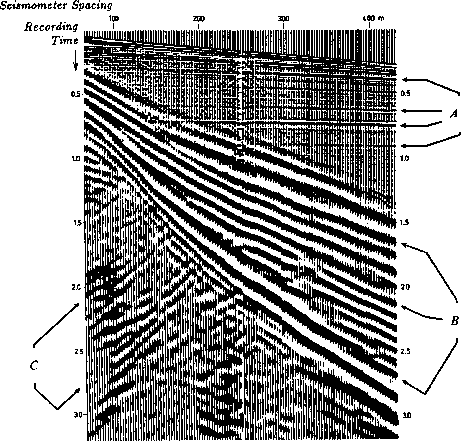




Next: SUBTRACT ANY TWO SHOT
Up: Claerbout: Factorizing 2-D seismic
Previous: Claerbout: Factorizing 2-D seismic
Recently, math professor George Papanicolaou
delivered a seminar to our Geophysics Department in which
he presented to us an amazing proposition:
Random scatterers can give us superresolution
because they can enlarge the effective aperture.
I will propose it this way:
Scatterers give rise to seismic coda.
Maybe we can use it effectively
even though we may not know the location of the scatterers.
In this paper I sketch how this could happen
in the realistic case of near-surface scattering
and I indicate how it could be tested and demonstrated.
Except for one essential feature,
the earth model that we examine in this initial exploratory phase
is a two-dimensional horizontally layered earth.
The essential departure is that the top roughness
that acts as point scatterers.
We might think of it as fine scale surface topography.
Alternately, we might think of it as
a thin water layer with boulders strewn around,
all acting as point scatterers of random amplitude, polarity and location.
The one-dimensional earth model itself has arbitrary velocity v(z),
multiple reflections, shear waves, anisotropy, etc.
Visualize this geometry:
s g
. r1 r2 r3 r4 r5 r6 r7 r8 r9
.
.
.
.
.
. __________________________
We are interested in ray paths like the one
from the shot s to the reflector,
to the rock r9, to the reflector, to the geophone g.
Both paths to and from the rock r9
include all arrivals, both direct and reflected.
We convolve
the 1-D simple earth's s to r9
response with its r9 to g response.
Whatever the response is to one rock,
the response to all the rocks will be
the one-rock response convolved horizontally by random numbers.
There will be several conjectures.
The simplest is that from a zero-offset section,
spectral factorization Kolmogoroff (1939)
via the helix Claerbout (1998) manufactures a common midpoint gather
from which we can do velocity analysis.
shell
Figure 1
Shell shot gather from IEI page 172 (paper version) section 3.2.
(/book/iei/Fig/ofs/shell.ps)
Observe the scattered ground roll with its apex at 250 m offset.
It is interesting to identify
the ray paths of ALL the backscattered energy.
Might you believe the diffraction at 250 m offset
is a weaker copy of the entire shot gather
but shifted 250 m and .17 s?
If you do, you will recognize that this copy also contains
(albeit weakly)
the near zero offset traces that are missing from the
the recording of the gather itself.






Next: SUBTRACT ANY TWO SHOT
Up: Claerbout: Factorizing 2-D seismic
Previous: Claerbout: Factorizing 2-D seismic
Stanford Exploration Project
4/27/2000
